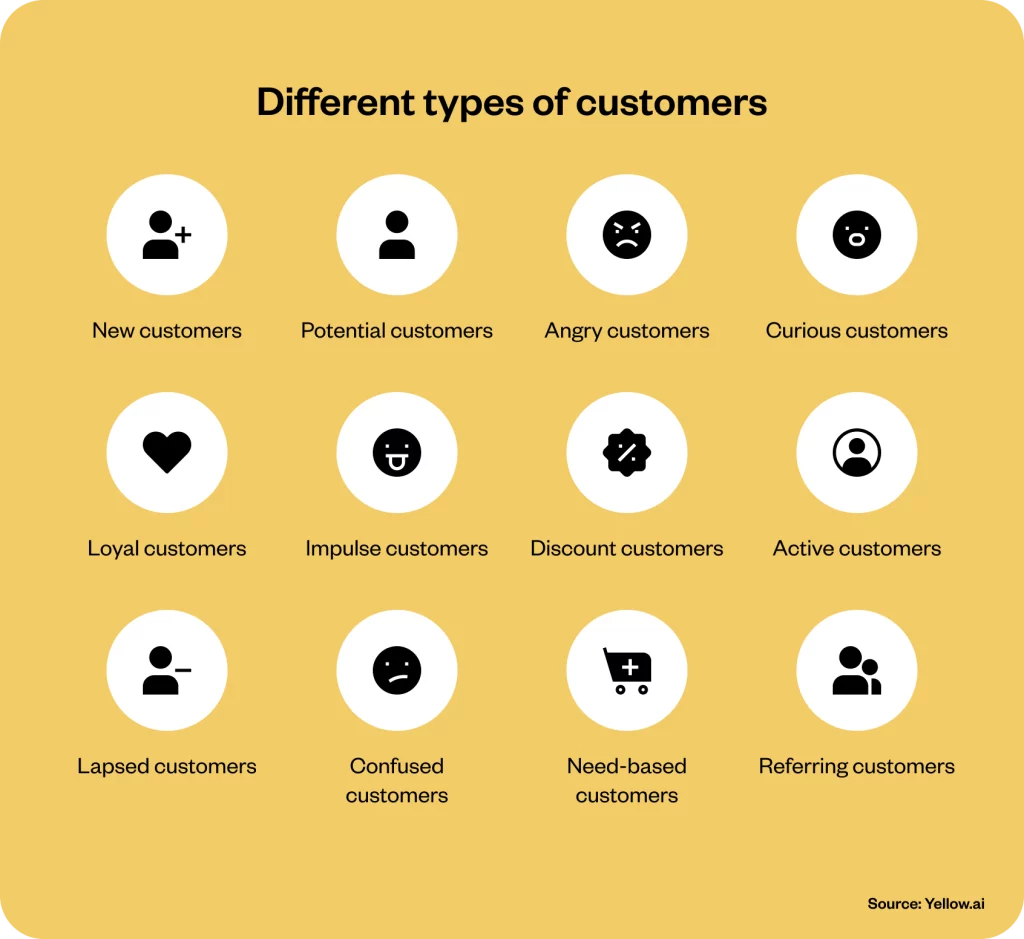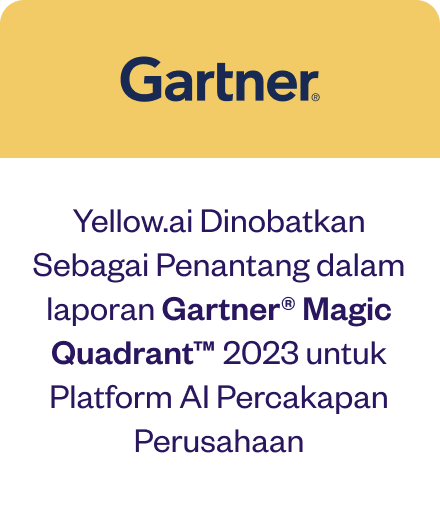Ringkasan eksekutif
Blog ini menyelam ke jantung keragaman pelanggan, mengidentifikasi berbagai jenis pelanggan yang ditemui dalam layanan pelanggan, pemasaran, penjualan, dan pengaturan bisnis. Dengan strategi yang disesuaikan untuk melibatkan tipe pelanggan baru, potensial, setia, impulsif, dan berbagai lainnya, blog ini menawarkan wawasan bagi bisnis yang tertarik untuk meningkatkan permainan dukungan pelanggan mereka. Belajarlah untuk menavigasi nuansa interaksi pelanggan secara efektif, memastikan pendekatan yang dipersonalisasi yang sesuai dengan setiap pelanggan unik, sehingga meningkatkan kepuasan dan loyalitas.
Perkenalan
Bayangkan ini: Anda berdiri di pasar, setiap kios menawarkan sesuatu yang unik, mulai dari rempah-rempah yang semarak hingga barang-barang buatan tangan. Sama seperti setiap kios menarik jenis pembelanja yang berbeda, bisnis Anda bertemu dengan berbagai jenis pelanggan, masing-masing dengan kebutuhan dan harapannya yang unik. Mengenali dan beradaptasi dengan beragam persona pelanggan ini sangat penting untuk kelangsungan hidup dan pertumbuhan dalam lanskap kompetitif saat ini. Studi terbaru menunjukkan bahwa sebanyak 65% pelanggan telah beralih merek karena pesaing lebih baik melayani mereka dengan lebih baik. Statistik ini menggarisbawahi kebutuhan mendesak bagi dunia usaha untuk memahami berbagai jenis pelanggan dan juga menyesuaikan pendekatan mereka untuk memenuhi beragam kebutuhan ini secara efektif.
AI dan alat segmentasi pelanggan merevolusi cara kita memahami dan berinteraksi dengan klien kita. Ini menawarkan wawasan yang belum pernah terjadi sebelumnya tentang preferensi dan perilaku mereka. Dengan memanfaatkan teknologi semacam itu, bisnis dapat menyusun pengalaman yang dipersonalisasi yang mencapai sasaran setiap saat. Namun, tantangannya tetap ada: bagaimana kita menerjemahkan wawasan ini ke dalam tindakan? Bagaimana kita memastikan bahwa setiap pelanggan merasa didengar, dihargai, dan dipahami? Blog ini bertujuan untuk menjelaskan berbagai jenis pelanggan dan menyajikan strategi yang dapat ditindaklanjuti untuk menyenangkan masing-masing pelanggan. Melakukan hal itu dapat membantu bisnis mengubah browser kasual menjadi pelanggan setia dan memastikan bisnis Anda menonjol di pasar yang ramai.
Harus-baca terkait:
- Onboarding pelanggan – Proses, contoh, dan kesalahan yang harus dihindari
- Umpan balik pelanggan: Jenis + 8 cara mengumpulkannya
Dinamika pelanggan yang beragam: Suatu keharusan bisnis
Menavigasi dunia interaksi pelanggan yang beragam sama seperti mengarahkan kapal melalui perairan yang penuh dengan beragam biota laut. Setiap pelanggan, unik dalam kebutuhan dan harapan mereka, mencerminkan beragam spesies di bawah ombak. Mengenali dan beradaptasi dengan beragam jenis pelanggan merupakan kebutuhan bagi bisnis yang ingin berkembang di pasar yang kompetitif saat ini. Inti dari memahami tipe pelanggan yang berbeda terletak pada kesadaran bahwa setiap interaksi adalah kesempatan untuk menjalin hubungan yang lebih dalam, pengalaman yang disesuaikan, dan, pada akhirnya, mengubah browser biasa menjadi pelanggan setia.
Mengapa penekanan pada diferensiasi? Bayangkan berjalan ke butik di mana petugas menyapa Anda dengan nama, mengingat preferensi Anda, dan menyarankan produk yang sempurna selaras dengan selera Anda. Pendekatan yang dipersonalisasi ini membuat Anda merasa dihargai dan juga secara signifikan meningkatkan kemungkinan pembelian. Demikian pula, bisnis yang membedakan nuansa halus di antara pelanggannya dapat menawarkan solusi khusus yang dapat diterima secara pribadi. Studi menyoroti kebenaran yang menarik: 33% pelanggan yang mengejutkan mungkin meninggalkan merek hanya setelah satu pengalaman buruk. Statistik ini menggarisbawahi pentingnya mengkurasi pengalaman yang mengakui dan memenuhi perjalanan unik setiap jenis pelanggan.
Perjalanan pelanggan dari rasa ingin tahu menuju kesetiaan dilapisi dengan titik kontak potensial dan peluang untuk keterlibatan. Dengan mensegmentasi pelanggan berdasarkan perilaku, preferensi, dan tahapan mereka dalam saluran penjualan, bisnis dapat merancang strategi yang ditargetkan untuk memenuhi kebutuhan dan aspirasi spesifik setiap segmen. Pendekatan seperti ini meningkatkan pengalaman pelanggan dan juga mendorong loyalitas dan advokasi merek. Ini meletakkan dasar yang kuat untuk pertumbuhan bisnis yang berkelanjutan. Saat kami menjelaskan jenis pelanggan dan strategi yang dipesan lebih dahulu untuk melibatkan mereka, ingatlah bahwa tujuannya adalah mengubah setiap interaksi menjadi batu loncatan untuk membangun hubungan pelanggan yang langgeng.
Tertarik untuk mentransformasi customer service Anda?

12 Berbagai jenis pelanggan
Menavigasi beragam jenis pelanggan sangat penting untuk menciptakan pengalaman pelanggan yang personal dan efektif. Setiap kategori pelanggan hadir dengan harapan dan kebutuhan unik, dan memahami perbedaan ini memungkinkan bisnis untuk terlibat secara lebih bermakna dan mendorong kepuasan.

Berikut adalah ikhtisar singkat dari berbagai jenis pelanggan:
- Pelanggan baru
- Pelanggan potensial
- Pelanggan marah
- Pelanggan penasaran
- Pelanggan setia
- Pelanggan impuls
- Pelanggan diskon
- Pelanggan aktif
- Pelanggan yang sudah kadaluwarsa
- Pelanggan bingung
- Pelanggan berbasis kebutuhan
- Merujuk pelanggan
1. Pelanggan baru
Pelanggan baru adalah mereka yang baru-baru ini memutuskan untuk terlibat dengan merek Anda untuk pertama kalinya. Keingintahuan, kebutuhan spesifik, atau kampanye pemasaran yang persuasif mungkin mendorong interaksi mereka.
Biasanya, pelanggan baru mendekati merek Anda dengan campuran kegembiraan dan kehati-hatian. Mereka berharap tentang nilai yang dijanjikan produk atau layanan Anda tetapi tetap waspada terhadap tanda-tanda yang mungkin bertentangan dengan harapan mereka.
Apa yang mereka butuhkan:
- Proses orientasi yang lancar: Pengenalan yang jelas dan langsung ke produk atau layanan Anda yang memandu mereka tentang cara mendapatkan hasil maksimal dari pembelian mereka.
- Bantuan segera untuk pertanyaan dasar: Dukungan pelanggan yang dapat diakses yang dapat membantu menyelesaikan ketidakpastian awal tanpa penundaan.
- Perjalanan pelanggan yang mulus: Jalur yang intuitif dan tidak merepotkan mulai dari penemuan hingga pembelian hingga penggunaan, meminimalkan gesekan apa pun yang dapat menyebabkan pikiran kedua.
Menjaga mereka bahagia:
- Berikan bukti sosial yang meyakinkan: Bagikan testimonial, peringkat, dan ulasan pelanggan di awal perjalanan mereka untuk memperkuat keputusan mereka secara positif.
- Komunikasi orientasi: Memanfaatkan email selamat datang, tutorial, dan konten pendidikan untuk menjelaskan produk atau layanan Anda, mendorong eksplorasi dan penggunaan.
- Dukungan pelanggan yang luar biasa: Pastikan bahwa dukungan sudah tersedia, berempati, dan efisien untuk membangun kepercayaan dan hubungan di luar transaksi pertama.
2. Pelanggan potensial
Pelanggan potensial adalah penjelajah di ambang menemukan produk atau layanan Anda. Mereka telah memetakan wilayah dengan berlangganan buletin Anda, memberi sinyal minat mereka melalui keterlibatan media sosial, atau bahkan menempatkan produk di keranjang belanja mereka. Namun, mereka berada di ambang pintu, memikirkan lompatan terakhir untuk menjadi pelanggan penuh.
Pelanggan potensial sedang dalam tahap pertimbangan. Mereka mengevaluasi penawaran Anda terhadap kebutuhan mereka dan mungkin membandingkannya dengan pesaing Anda.
Apa yang mereka butuhkan:
- Proposisi nilai yang jelas: Informasi yang menyoroti bagaimana produk atau layanan Anda mengatasi titik atau kebutuhan spesifik mereka.
- Keterlibatan dan pengasuhan: Komunikasi teratur dan berbasis nilai yang membangun minat mereka dan membimbing mereka menuju pengambilan keputusan pembelian.
- Bukti manfaat: Demonstrasi tentang bagaimana orang lain telah berhasil menggunakan produk atau layanan Anda untuk mencapai tujuan mereka.
Menjaga mereka bahagia:
- Pengalaman yang ramah pengguna: Pastikan situs web Anda dan semua titik kontak mudah dinavigasi dan bebas dari rintangan yang mungkin menghalangi keterlibatan.
- Komunikasi yang dipersonalisasi: Sesuaikan pesan dan konten dengan minat dan interaksi mereka dengan merek Anda, menunjukkan Anda memahami dan menghargai kebutuhan unik mereka.
- Insentifkan tindakan: Gunakan penawaran bertarget atau konten eksklusif untuk mendorong mereka mengambil langkah berikutnya.
3. Pelanggan marah
Pelanggan yang memiliki pengalaman negatif dengan produk, layanan, atau bagian mana pun dari interaksi mereka dengan merek Anda. Ketidakpuasan mereka bisa berasal dari harapan yang tidak terpenuhi, masalah produk, atau kekurangan layanan.
Rasa ketidakadilan atau kekecewaan mendorong pelanggan yang marah. Mereka meminta pengakuan atas keluhan mereka dan penyelesaian yang memuaskan.
Apa yang mereka butuhkan:
- Pengakuan segera: Pengakuan atas keluhan dan jaminan mereka bahwa masalah mereka ditanggapi dengan serius.
- Respons empatik dan proaktif: Pendekatan berorientasi solusi yang mengatasi akar penyebab ketidakpuasan mereka.
- Tindak lanjut dan jaminan: Konfirmasi bahwa masalah telah diselesaikan untuk kepuasan mereka dan langkah-langkah telah diambil untuk mencegah masalah di masa depan.
Menjaga mereka bahagia:
- Saluran dukungan responsif: Pastikan bahwa layanan pelanggan Anda dapat diakses, responsif, dan mampu menangani keluhan secara efisien.
- Permintaan maaf dan kompensasi yang tulus: Tawarkan permintaan maaf yang tulus dan, jika diperlukan, kompensasi yang sesuai dengan tingkat ketidaknyamanan yang mereka alami.
- Putaran umpan balik: Terapkan umpan balik mereka ke dalam operasi Anda untuk meningkatkan kualitas produk atau layanan, menunjukkan bahwa Anda menghargai masukan mereka dan berkomitmen untuk perbaikan berkelanjutan.
4. Pelanggan penasaran
Pelanggan ini menunjukkan tingkat minat yang tinggi terhadap produk atau layanan Anda tetapi belum mengambil keputusan. Mereka sedang dalam tahap eksplorasi, mengumpulkan informasi dan membandingkan pilihan.
Pelanggan yang penasaran adalah pencari informasi. Mereka terbuka untuk menemukan solusi baru namun memerlukan kejelasan dan bukti untuk membuat keputusan yang tepat.
Apa yang mereka butuhkan:
- Informasi terperinci: Akses ke detail komprehensif tentang penawaran Anda, termasuk fitur, manfaat, dan perbandingan.
- Bimbingan dan pendidikan: Sumber daya seperti panduan, video petunjuk, dan webinar yang dapat membantu mereka memahami bagaimana produk atau layanan Anda cocok dengan kehidupan atau bisnis mereka.
- Akses mudah ke dukungan: Saluran di mana mereka dapat mengajukan pertanyaan dan menerima tanggapan tepat waktu.
Menjaga mereka bahagia:
- Materi pendidikan yang ramah pengguna: Pastikan konten pendidikan Anda mudah dicerna dan menarik, membantu mereka memahami nilai penawaran Anda dengan cepat.
- Layanan pelanggan yang responsif: Berikan dukungan yang tersedia dan berpengetahuan luas untuk menjawab pertanyaan apa pun yang mungkin mereka miliki.
- Rekomendasi yang dipersonalisasi: Berdasarkan perilaku dan minat mereka, sarankan produk atau layanan yang memenuhi kebutuhan spesifik mereka.
5. Pelanggan setia
Pelanggan yang telah berulang kali memilih merek Anda daripada pesaing dan mengadvokasi produk atau layanan Anda berdasarkan pengalaman positif mereka.
Pelanggan setia telah mengembangkan kepercayaan yang mendalam terhadap merek Anda. Mereka menghargai nilai dan pengalaman yang diberikan produk atau layanan Anda dan sering kali membentuk hubungan emosional dengan merek Anda.
Apa yang mereka butuhkan:
- Pengakuan dan penghargaan: Pengakuan atas kesetiaan dan kontribusi mereka terhadap merek Anda.
- Penawaran dan hadiah eksklusif: Akses ke penawaran khusus, rilis produk awal, atau program loyalitas yang menghargai patronase berkelanjutan mereka.
- Kualitas dan inovasi yang konsisten: Jaminan bahwa produk atau layanan yang mereka sukai akan terus memenuhi standar tinggi mereka.
Menjaga mereka bahagia:
- Perawatan VIP: Tawarkan layanan yang dipersonalisasi, dukungan prioritas, dan fasilitas eksklusif untuk membuatnya merasa dihargai.
- Peluang keterlibatan: Undang mereka untuk menjadi bagian dari percakapan pengembangan produk atau program duta merek.
- Komunikasi reguler: Terus perbarui mereka dengan buletin, pembaruan produk, dan catatan penghargaan pribadi untuk memperkuat hubungan.
6. Pelanggan impuls
Pelanggan ini membuat keputusan pembelian spontan berdasarkan keinginan langsung atau penawaran menarik tanpa perencanaan sebelumnya untuk membeli produk tertentu.
Pelanggan impulsif didorong oleh emosi dan daya pikat kepuasan instan. Mereka tertarik pada penawaran, kebaruan, dan kegembiraan menemukan sesuatu yang baru atau bermanfaat saat itu juga.
Apa yang mereka butuhkan:
- Penawaran menarik: Penawaran atau promosi menarik yang menarik perhatian mereka dan mendorong tindakan segera.
- Pengalaman berbelanja yang mulus: Jalur tanpa gesekan dari penemuan ke pembelian, memastikan tidak ada rintangan dalam proses pembelian.
- Informasi produk yang jelas dan ringkas: Detail cepat dan lugas yang memungkinkan mereka membuat keputusan instan dengan percaya diri.
Menjaga mereka bahagia:
- Proses checkout yang disederhanakan: Pastikan proses pembelian sesederhana dan secepat mungkin, dengan langkah minimal hingga selesai.
- Sorot produk terkait: Gunakan algoritma untuk menyarankan item atau bundel terkait yang melengkapi pembelian impuls mereka, meningkatkan nilai pesanan.
- Melibatkan tampilan produk: Memanfaatkan gambar, video, dan salinan persuasif berkualitas tinggi untuk membuat produk tak tertahankan pada pandangan pertama.
7. Pelanggan diskon
Pelanggan ini terutama termotivasi oleh diskon dan penawaran. Mereka sensitif terhadap harga dan sering membuat keputusan pembelian berdasarkan penghematan yang ditawarkan produk atau layanan.
Pelanggan diskon adalah pembeli cerdas yang bangga menemukan penawaran terbaik dan paling banyak diskon. Pelanggan ini biasanya bersedia menunggu penjualan. Mereka juga ok dengan menghabiskan waktu meneliti untuk memastikan mereka mendapatkan nilai paling banyak untuk uang mereka.
Apa yang mereka butuhkan:
- Komunikasi penawaran yang jelas: Informasi tentang penjualan, diskon, dan promosi harus mudah dan mudah ditemukan.
- Jaminan nilai: Bahkan dengan harga diskon, pelanggan ini perlu merasa mendapatkan produk atau layanan berkualitas tinggi.
- Hadiah loyalitas: Insentif untuk pembelian atau rujukan yang sering mendorong pelanggan untuk kembali bahkan ketika tidak ada diskon.
Menjaga mereka bahagia:
- Penawaran eksklusif: Berikan penawaran khusus untuk pelanggan yang kembali atau mereka yang berlangganan buletin Anda untuk membuat mereka merasa dihargai.
- Jaminan kecocokan harga: Yakinkan mereka mendapatkan kesepakatan terbaik dengan menawarkan untuk mencocokkan harga yang lebih rendah yang ditemukan di tempat lain.
- Sistem notifikasi yang efisien: Gunakan peringatan email atau SMS untuk memberi tahu mereka tentang penjualan yang akan datang atau diskon eksklusif, menjaga merek Anda tetap diingat.
8. Pelanggan aktif
Pelanggan ini secara teratur berinteraksi dengan merek Anda dan sering melakukan pembelian tetapi belum tentu setia. Mereka terbuka untuk mengeksplorasi pilihan lain.
Pelanggan aktif terlibat dan memiliki disposisi positif terhadap merek Anda, tetapi penawaran pesaing dapat mempengaruhi loyalitas mereka. Mereka mencari kepuasan dan nilai yang berkelanjutan dari interaksi mereka.
Apa yang mereka butuhkan:
- Keterlibatan yang konsisten: Pembaruan rutin tentang produk, layanan, atau peningkatan baru agar mereka tetap tertarik.
- Pengalaman yang dipersonalisasi: Rekomendasi dan layanan yang disesuaikan berdasarkan preferensi dan riwayat pembelian mereka.
- Pengakuan: Pengakuan atas dukungan berkelanjutan mereka melalui penghargaan atau akses eksklusif terhadap penawaran baru.
Menjaga mereka bahagia:
- Program keanggotaan: Buat klub atau program eksklusif yang menawarkan manfaat dengan patronase berkelanjutan, meningkatkan rasa memiliki dan penghargaan mereka.
- Peluang umpan balik: Secara aktif mencari pendapat mereka tentang cara meningkatkan produk atau layanan, menunjukkan bahwa Anda menghargai masukan mereka dan berkomitmen untuk berkembang.
- Konten dinamis: Perbarui konten Anda secara berkala untuk memberikan informasi segar dan relevan yang memenuhi minat mereka dan membuat mereka tetap terlibat dengan merek Anda.
9. Pelanggan yang sudah kadaluwarsa
Pelanggan yang tidak aktif adalah pelanggan yang sebelumnya telah terlibat dengan merek Anda tetapi belum melakukan pembelian baru-baru ini. Mereka sebelumnya telah melakukan pembelian dengan merek tetapi tidak lagi terkait dengan merek Anda.
Pelanggan yang tidak bekerja mungkin mengalami perubahan preferensi, menemukan alternatif yang lebih baik, atau mengalami ketidakpuasan. Mereka akrab dengan merek Anda tetapi saat ini tidak aktif.
Apa yang mereka butuhkan:
- Insentif keterlibatan kembali: Penawaran atau informasi yang menghidupkan kembali minat mereka terhadap merek Anda.
- Pembaruan pada perbaikan: Komunikasi tentang setiap perubahan atau peningkatan baru yang mengatasi masalah sebelumnya atau menambah nilai.
- Koneksi ulang yang dipersonalisasi: Penjangkauan yang mengakui keterlibatan mereka sebelumnya dan mengundang mereka kembali dengan penawaran yang disesuaikan.
Menjaga mereka bahagia:
- Kampanye yang menang-kembali: Menerapkan kampanye yang ditargetkan yang dirancang untuk mengatasi alasan mereka untuk pergi dan menawarkan alasan kuat untuk kembali.
- Survei untuk mendapatkan wawasan: Lakukan survei di antara pelanggan yang kehilangan pekerjaan untuk memahami alasan mereka melepaskan diri dan gunakan umpan balik ini untuk melakukan penyesuaian yang diperlukan.
- Penawaran selamat datang kembali eksklusif: Berikan penawaran atau layanan khusus khusus khusus untuk pelanggan yang kembali agar mereka merasa dihargai dan mendorong keterlibatan kembali.
10. Pelanggan bingung
Pelanggan ini tidak yakin tentang bagaimana produk atau layanan Anda dapat memenuhi kebutuhan mereka atau bagaimana menavigasi penawaran Anda. Mereka mungkin memiliki pertanyaan atau memerlukan klarifikasi sebelum melakukan pembelian.
Pelanggan yang bingung sering merasa kewalahan dengan pilihan yang tersedia atau informasi yang disajikan. Mereka mencari kejelasan dan kepastian untuk melanjutkan dengan percaya diri.
Apa yang mereka butuhkan:
- Petunjuk yang sederhana dan jelas: Petunjuk yang lugas dan mudah dipahami.
- Aksesibilitas terhadap dukungan: Akses langsung ke saluran dukungan pelanggan di mana mereka dapat mencari bantuan atau menjawab pertanyaan mereka.
- Kepastian: Konfirmasi bahwa mereka membuat pilihan yang tepat dengan memilih produk atau layanan Anda.
Menjaga mereka bahagia:
- Bagian FAQ yang kuat: Kembangkan halaman FAQ komprehensif yang membahas masalah dan pertanyaan umum, memungkinkan mereka menemukan jawaban dengan cepat.
- Panduan atau demo interaktif: Tawarkan alat atau demonstrasi interaktif yang secara visual membimbing mereka melalui produk atau layanan Anda.
- Staf pendukung yang sabar dan pengertian: Pastikan tim layanan pelanggan Anda dilatih untuk menangani pertanyaan dengan kesabaran dan empati, membuat pelanggan yang bingung merasa dihargai dan didukung.
11. Pelanggan berbasis kebutuhan
Pelanggan yang melakukan pembelian berdasarkan kebutuhan atau masalah tertentu yang ingin segera mereka selesaikan.
Pelanggan ini fokus dan didorong oleh tujuan yang jelas. Mereka menghargai efisiensi dan efektivitas dan lebih memilih solusi yang secara langsung memenuhi kebutuhan mereka saat ini.
Apa yang mereka butuhkan:
- Solusi langsung: Informasi yang jelas dan ringkas tentang bagaimana produk atau layanan Anda dapat memecahkan masalah spesifik mereka.
- Akses cepat: Akses mudah dan cepat untuk membeli atau mendapatkan solusi yang mereka cari.
- Rekomendasi yang relevan: Saran yang selaras dengan kebutuhan dan preferensi mereka saat ini.
Menjaga mereka bahagia:
- Pengalaman berbelanja yang efisien: Optimalkan proses pembelian untuk meminimalkan hambatan dan memungkinkan pengambilan keputusan yang cepat.
- Saran produk yang disesuaikan: Gunakan wawasan berbasis data untuk menawarkan rekomendasi yang dipersonalisasi yang sesuai dengan kebutuhan mendesak mereka.
- Dukungan responsif: Memberikan layanan pelanggan yang cepat dan efisien untuk membantu setiap pertanyaan atau masalah yang mungkin mereka hadapi.
12. Merujuk pelanggan
Pelanggan yang tidak hanya puas dengan merek Anda tetapi juga antusias untuk merekomendasikan produk atau layanan Anda kepada orang lain.
Pelanggan ini memiliki hubungan positif yang kuat dengan merek Anda dan senang berbagi pengalaman positif mereka dengan jaringan mereka.
Apa yang mereka butuhkan:
- Pengakuan atas upaya mereka: Apresiasi atas rujukan dan informasi positif yang mereka hasilkan.
- Alat untuk membuat rujukan mudah: Cara sederhana dan efektif untuk berbagi rekomendasi mereka dengan teman dan keluarga.
- Insentif untuk rujukan: Imbalan atau manfaat yang mengakui kontribusi mereka untuk menumbuhkan basis pelanggan Anda.
Menjaga mereka bahagia:
- Program rujukan: Menerapkan program rujukan yang menawarkan hadiah atau insentif baik untuk pelanggan yang merujuk dan pelanggan baru yang mereka bawa.
- Pembaruan atau pratinjau eksklusif: Beri mereka akses awal ke produk, layanan, atau konten baru sebagai tanda penghargaan atas loyalitas dan advokasi mereka.
- Keterlibatan dan pengakuan: Terlibat secara aktif dengan merujuk pelanggan di media sosial atau platform lain, mengakui kontribusi mereka dan menumbuhkan rasa kebersamaan.
Bagaimana Yellow.ai bisa menyenangkan setiap jenis pelanggan?
Yellow.ai membawa pendekatan dinamis untuk keterlibatan pelanggan, memanfaatkan kekuatan AI untuk memahami dan memenuhi beragam kebutuhan berbagai jenis pelanggan:
- Interaksi yang dipersonalisasi: Memanfaatkan Pemrosesan Bahasa Alami (NLP) yang canggih, alat Yellow.ai dapat membedakan niat pelanggan, memungkinkan komunikasi yang dipersonalisasi yang sesuai dengan kebutuhan dan preferensi spesifik setiap pelanggan.
- Dukungan otomatis: Melalui Agen AI Dinamis, platform ini memastikan bahwa pelanggan baru menerima sambutan hangat, calon pelanggan dibina dengan informasi yang relevan, dan bahkan pelanggan yang paling frustrasi pun menemukan resolusi cepat atas kekhawatiran mereka.
- Keterlibatan real-time: Dengan Kehadiran Omnichannel-nya, Yellow.ai bertemu pelanggan di mana mereka berada, baik itu di media sosial, aplikasi perpesanan, atau situs web perusahaan. Ini memastikan pengalaman yang mulus dan konsisten di semua platform.
- Wawasan berbasis data: Memanfaatkan AI dan Machine Learning, Yellow.ai menawarkan wawasan bisnis tentang perilaku, preferensi, dan umpan balik pelanggan. Hal ini memungkinkan bisnis untuk menyesuaikan layanan dan produk mereka secara lebih efektif untuk memenuhi permintaan pelanggan.
Dengan mengintegrasikan Yellow.ai ke dalam strategi layanan pelanggan Anda, Anda membuka pintu ke dunia di mana setiap interaksi pelanggan adalah kesempatan untuk mengesankan, terlibat, dan mempertahankan. Teknologi memahami nuansa tipe pelanggan dan juga mengantisipasi kebutuhan mereka. Ini memberikan layanan yang memuaskan dan menyenangkan.
Kisah sukses

Indigo meningkatkan kepuasan pelanggan
Pelajari bagaimana Indigo meningkatkan kepuasan pelanggan hingga 87% dengan otomatisasi AI

Hyundai meningkatkan pendapatan dan meningkatkan layanan pelanggan dengan otomatisasi AI
Jelajahi bagaimana otomatisasi Yellow.ai menghasilkan ~1000 penjualan mobil, tingkat konversi ritel 10%, dan lebih dari 1,4 juta tayangan pengguna

Pelago menata ulang pengalaman pelanggan dengan agen AI percakapan bertenaga AI generatif
Hanya dalam waktu enam minggu setelah ditayangkan, Pelago tidak hanya menerima lebih dari 5.000 pengguna tetapi juga mencapai tingkat defleksi sebesar 50!
Siap untuk meningkatkan strategi keterlibatan pelanggan Anda? Pesan demo dengan Yellow.ai hari ini dan mulailah perjalanan untuk mengubah interaksi pelanggan Anda.
Pemikiran terakhir
Sebagai penutup, memahami dan menangani berbagai tipe pelanggan bukan sekadar kebutuhan bisnis; itu adalah keuntungan strategis. Pasar modern menuntut pendekatan yang bernuansa, pendekatan yang mengakui individualitas setiap pelanggan dan menyesuaikan pengalaman agar sesuai. Dengan kemajuan dalam AI dan pembelajaran mesin, alat seperti Yellow.ai mendefinisikan ulang apa yang mungkin. Ini menawarkan bisnis kesempatan untuk memenuhi dan melampaui harapan pelanggan. Saat kita melihat ke masa depan, jelas bahwa merek yang berhasil adalah merek yang memandang setiap interaksi pelanggan sebagai peluang untuk mengesankan, terlibat, dan menyenangkan.
Pertanyaan yang sering diajukan (FAQ)
Apa saja 4 jenis utama kategori pelanggan?
Empat kategori utama pelanggan sering termasuk Pelanggan Baru, yang terlibat dengan merek Anda untuk pertama kalinya; Pelanggan Setia, yang telah membentuk hubungan jangka panjang dengan merek Anda; Pelanggan Impuls, yang membuat keputusan pembelian spontan; dan Pelanggan Diskon, yang terutama termotivasi oleh penawaran dan diskon. Memahami kategori-kategori ini membantu bisnis menyesuaikan pendekatan mereka untuk keterlibatan maksimum.
Bagaimana kita mengklasifikasikan pelanggan?
Pelanggan dapat diklasifikasikan berdasarkan berbagai kriteria, seperti perilaku membeli mereka, loyalitas terhadap merek, tahap keterlibatan dengan produk atau layanan, dan kebutuhan atau motivasi mereka. Klasifikasi ini memungkinkan bisnis untuk menerapkan strategi pemasaran yang ditargetkan dan mempersonalisasi layanan pelanggan.
apakah jenis pelanggan dalam layanan pelanggan?
Dalam layanan pelanggan, pelanggan dapat dikategorikan sebagai Puas, yang telah memenuhi harapan mereka; Tidak puas, yang memiliki pengalaman negatif; Setia, yang secara konsisten memilih merek Anda; dan Potensi, yang sedang mempertimbangkan penawaran Anda tetapi belum melakukan pembelian.
Apa saja 3 jenis pelanggan di call center?
Dalam dunia call center yang dinamis, ada tiga tipe pelanggan utama yang menonjol. Penyelidik sedang mencari informasi, mencari kejelasan dan arahan. Pemecah masalah datang dengan tantangan di tangan, mencari solusi dan memperbaiki masalah mereka. Terakhir, pemberi umpan balik adalah suara pengalaman dan sangat ingin berbagi wawasan atau saran yang dapat meningkatkan kualitas layanan. Mengenali kategori-kategori ini memungkinkan agen pusat panggilan untuk menyesuaikan interaksi mereka, memastikan setiap panggilan bergerak menuju resolusi yang memuaskan.
Apa saja jenis pelanggan yang berbeda di ritel?
Dalam ritel, pelanggan bisa menjadi Pemburu Tawar-menawar, mencari penawaran terbaik; Loyalis, yang secara konsisten berbelanja di toko Anda; Pembeli Impuls, yang melakukan pembelian spontan; dan Pembeli Jendela, yang menjelajah tanpa niat yang jelas untuk segera membeli.
Apa saja jenis pelanggan yang berbeda dalam pemasaran?
Lanskap pemasaran kaya dengan keragaman, di mana pelanggan dikategorikan untuk menyempurnakan pesan dan strategi. Demografi mengiris pasar dengan sifat-sifat nyata seperti usia atau pendapatan, menawarkan gambaran yang jelas tentang siapa pelanggan. Psikografi menggali lebih dalam, mengeksplorasi nilai-nilai dan gaya hidup yang mendorong keputusan pelanggan. Segmentasi geografis menganggap lokasi sebagai faktor penting dalam pendekatan pemasaran. Terakhir, segmentasi Perilaku melihat bagaimana pelanggan berinteraksi dengan merek, dengan fokus pada kebiasaan dan preferensi mereka. Tampilan multi-sudut ini membantu pemasar menyusun kampanye yang beresonansi secara mendalam dan mendorong keterlibatan.



















